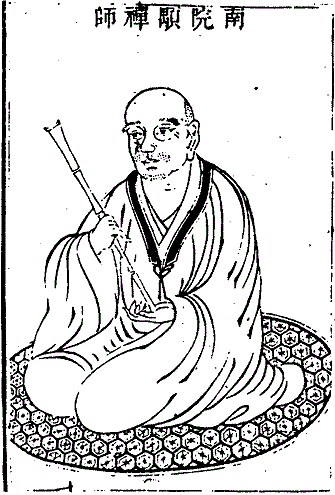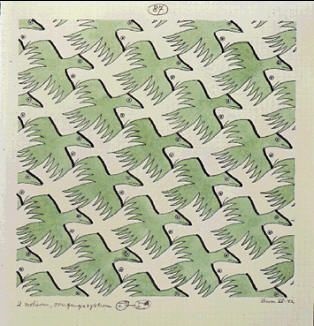ZEN IRODALOM ZEN LITERATURE
« Zen főoldal
« vissza a Terebess Online nyitólapjára

南院慧顒 "寶應" Nanyuan Huiyong "Baoying" (860-930)
(Rōmaji:) Nan'in Egyō "Hōō"
Tartalom |
Contents |
| Nan-jüan Huj-jung mondásaiból Fordította: Terebess Gábor |
Nanyuan Huiyong "Baoying" |
Nanyuan Huiyong's Dharma Lineage
[...]
菩提達磨 Bodhidharma, Putidamo (Bodaidaruma ?-532/5)
大祖慧可 Dazu Huike (Taiso Eka 487-593)
鑑智僧璨 Jianzhi Sengcan (Kanchi Sōsan ?-606)
大毉道信 Dayi Daoxin (Daii Dōshin 580-651)
大滿弘忍 Daman Hongren (Daiman Kōnin 601-674)
大鑑慧能 Dajian Huineng (Daikan Enō 638-713)
南嶽懷讓 Nanyue Huairang (Nangaku Ejō 677-744)
馬祖道一 Mazu Daoyi (Baso Dōitsu 709-788)
百丈懷海 Baizhang Huaihai (Hyakujō Ekai 750-814)
黃蘗希運 Huangbo Xiyun (Ōbaku Kiun ?-850)
臨濟義玄 Linji Yixuan (Rinzai Gigen ?-866)
興化存獎 Xinghua Cunjiang (Kōke Zonshō 830-888)
南院慧顒 Nanyuan Huiyong (Nan'in Egyō ?-952)
Nanyuan Huiyong "Baoying"
by Andy Ferguson
In: Zen's Chinese Heritage: The Masters and Their Teachings, Wisdom Publications, pp. 273-275.
NANYUAN HUIYONG (860–930) was a disciple of Xinghua Cunjiang. He came from ancient Hebei. Nanyuan was extremely strict and uncompromising in his approach to teaching Zen. He lived and taught at the “South Hall” (in Chinese, Nanyuan) of the Baoying Zen Monastery at Ruzhou. Nanyuan is the most important teacher of the third generation of the Linji school, and is a direct link in the lineage that stretches down to modern times.
*
Nanyuan entered the hall and said to the assembled monks, “On top of a lump of red flesh, a sheer precipice of eight thousand feet.”
A monk asked, “‘On top of a lump of red flesh, a sheer precipice of eight thousand feet.’ Isn’t this what you said?”
Nanyuan said, “It is.”
The monk then lifted and turned over the meditation bench.
Nanyuan exclaimed, “This blind ass has run riot!”
The monk started to speak.
Nanyuan hit him.
*
Nanyuan asked a monk, “Where have you come from?”
The monk said, “From Longwater.”
Nanyuan asked him, “Did it flow east or west?”
The monk said, “Neither way.”
Nanyuan then asked, “What did it do?”
The monk bowed and began to leave.
Nanyuan hit him.
*
A monk came for instruction. Nanyuan raised his whisk.
The monk said, “Today a failure.”
Nanyuan put down the whisk.
The monk said, “Still a failure.”
Nanyuan hit him.
*
Nanyuan asked a monk, “Where did you come from?”
The monk said, “From Xiangzhou.”
Nanyuan said, “What did you come here for?”
The monk said, “I came especially to pay respects to the master.”
Nanyuan said, “You’ve come here just when old Baoying isn’t here.”
The monk shouted.
Nanyuan said, “I said Baoying isn’t here. What good will it do to shout anymore?”
The monk shouted again.
Nanyuan hit him.
The monk bowed.
Nanyuan said, “Actually, you have struck me, so I hit you back. You want this to be widely known. Blind fellow! Go to the hall!”
*
A monk asked, “What is a seamless monument?”
Nanyuan said, “Eight seams and nine cracks.”
The monk asked, “What is the person inside the monument?”
Nanyuan said, “Hair uncombed. Face unwashed.”
*
Nanyuan asked a monk, “What is your name?”
The monk said, “Pucan [‘Practice Everywhere’].”
Nanyuan said, “What would you do if you encountered a turd?”
The monk bowed.
Nanyuan hit him.
*
A monk asked Nanyuan, “When the sacred and the mundane abide in the same place, then what?”
Nanyuan said, “Two cats. One of them is fierce.”
*

Nan-jüan Huj-jung összegyűjtött mondásaiból
Fordította: Terebess Gábor
Folyik a híd, Officina Nova, Budapest, 1990, 79. oldal
– Hol van az Út? – kérdezte egy szerzetes.
– Ha kánya repül át a nagy égen, nincs utána semmi nyom – felelte Nan-jüan.

“A flying bird leaves no traces.”
Two Birds [Nº 87] (1952) by M.C. Escher

Tarnóczy Zoltán illusztrációja